wheel NISSAN MAXIMA 2006 A34 / 6.G Towing Guide
[x] Cancel search | Manufacturer: NISSAN, Model Year: 2006, Model line: MAXIMA, Model: NISSAN MAXIMA 2006 A34 / 6.GPages: 28, PDF Size: 2.12 MB
Page 4 of 28

2006 Nissan Towing Guide 3 If you are buying a travel or boat trailer, be sure that your Nissan vehicle has the towing
capacity to pull it. See the SPECIFICATIONS section of this guide, or refer to your owner’s
manual for detailed information regarding the towing capacity of your specific vehicle. Your
owner’s manual should ALWAYS be referenced before making any towing decisions.
Naturally, you’ll want to buy the highest-quality equipment you can find for maximum
towing safety. And if you plan to tow often, consider convenience. Quick-disconnect trailer
light connectors and ratchet-type tie-downs, for example, make the job go faster and easier,
and are usually worth the small extra investment.
WHAT’S
RIGHT FOR YOU
TYPES OF EQUIPMENT
Towing requires a variety of equipment, and, depending upon the application, there can be
several types or styles of each piece of equipment. Working with your Nissan dealer or a
professional supplier of towing equipment, it should be relatively simple to determine the
proper type of equipment for your specific vehicle given the intended application. This
section explains the most common pieces of towing equipment available.
HITCHES
Whichever type of hitch you use, it should be firmly bolted to your vehicle, and should be of
the appropriate weight class for the equipment you intend to tow. In addition, keep the
following in mind:
�Š Do not modify the vehicle’s braking or exhaust systems or its body structure/frame when
installing the hitch.
�Š Be sure that the hitch does not interfere in any way with the vehicle’s energy-absorbing
bumper.
�Š Regularly check to see that all hitch-mounting bolts are securely fastened.
�Š Where practical, remove the hitch when not in use. Your Nissan dealer can assist you in
hitch removal and reinstallation. When removed, seal the bolt holes to prevent road
spray, fumes, water, and dirt from entering the vehicle.
�Š For receiver-type hitches using a ball mount, the ball mount should be removed when
not towing.
�Š If you install a hitch yourself, remember that it must be securely attached to the frame or
underbody, according to the manufacturer’s instructions. Never attach a hitch or
towing device to the vehicle axle housing. This may damage the housing, wheel
bearings, wheels, or tires.
Page 6 of 28
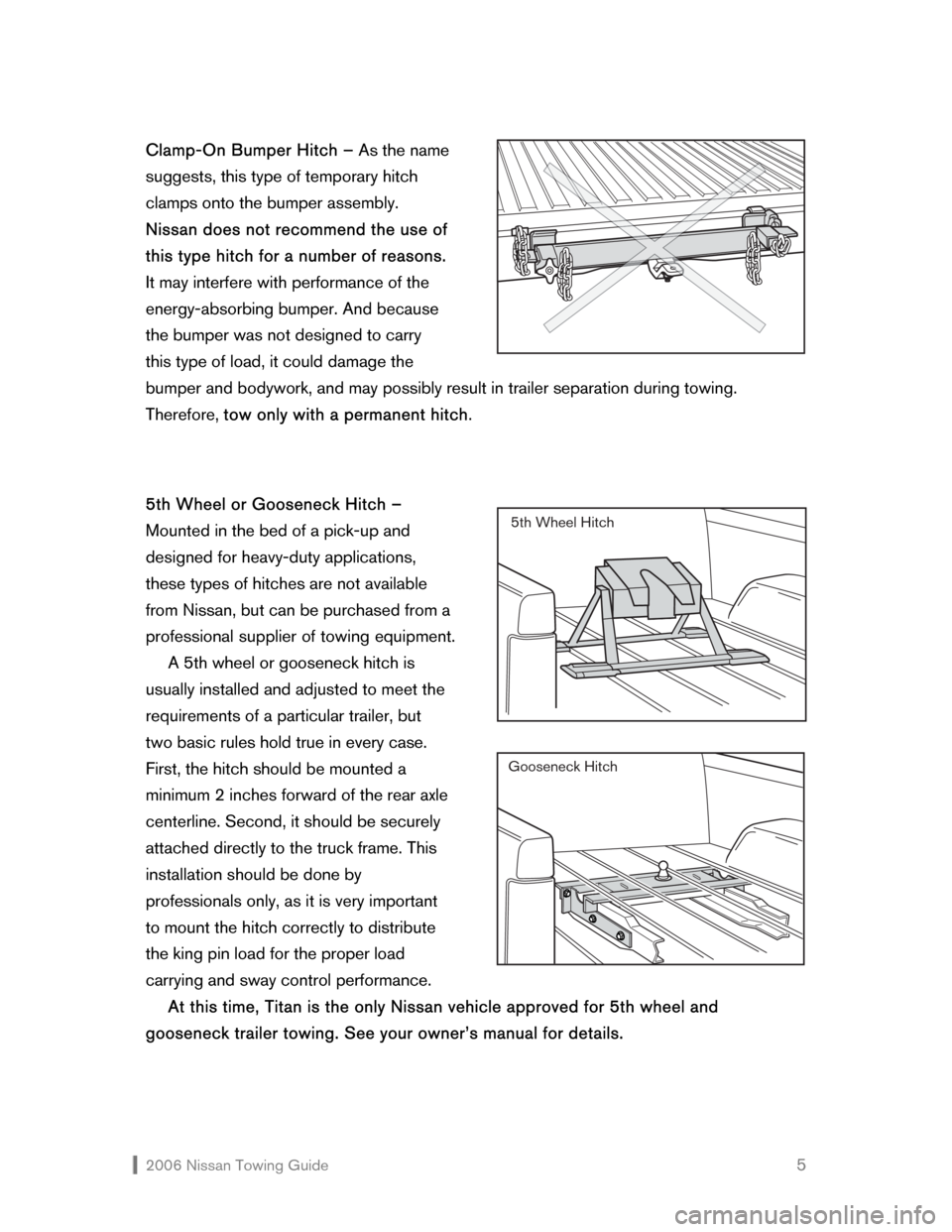
2006 Nissan Towing Guide 5 Clamp-On Bumper Hitch – As the name
suggests, this type of temporary hitch
clamps onto the bumper assembly.
Nissan does not recommend the use of
this type hitch for a number of reasons.
It may interfere with performance of the
energy-absorbing bumper. And because
the bumper was not designed to carry
this type of load, it could damage the
bumper and bodywork, and may possibly result in trailer separation during towing.
Therefore, tow only with a permanent hitch.
5th Wheel or Gooseneck Hitch –
Mounted in the bed of a pick-up and
designed for heavy-duty applications,
these types of hitches are not available
from Nissan, but can be purchased from a
professional supplier of towing equipment.
A 5th wheel or gooseneck hitch is
usually installed and adjusted to meet the
requirements of a particular trailer, but
two basic rules hold true in every case.
First, the hitch should be mounted a
minimum 2 inches forward of the rear axle
centerline. Second, it should be securely
attached directly to the truck frame. This
installation should be done by
professionals only, as it is very important
to mount the hitch correctly to distribute
the king pin load for the proper load
carrying and sway control performance.
At this time, Titan is the only Nissan vehicle approved for 5th wheel and
gooseneck trailer towing. See your owner’s manual for details.
5th Wheel Hitch
Gooseneck Hitch
Page 7 of 28
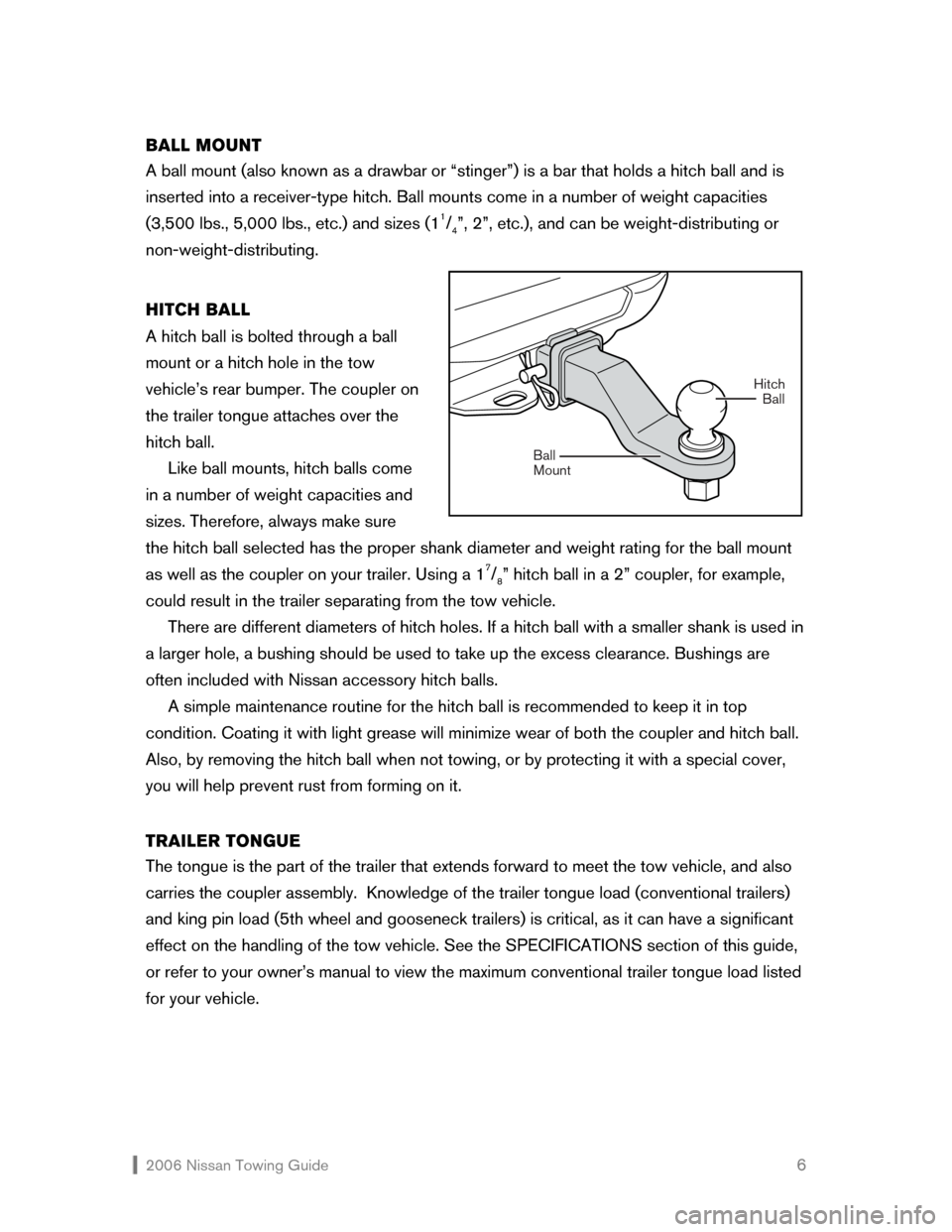
2006 Nissan Towing Guide 6 BALL MOUNT
A ball mount (also known as a drawbar or “stinger”) is a bar that holds a hitch ball and is
inserted into a receiver-type hitch. Ball mounts come in a number of weight capacities
(3,500 lbs., 5,000 lbs., etc.) and sizes (1
1/4”, 2”, etc.), and can be weight-distributing or
non-weight-distributing.
HITCH BALL
A hitch ball is bolted through a ball
mount or a hitch hole in the tow
vehicle’s rear bumper. The coupler on
the trailer tongue attaches over the
hitch ball.
Like ball mounts, hitch balls come
in a number of weight capacities and
sizes. Therefore, always make sure
the hitch ball selected has the proper shank diameter and weight rating for the ball mount
as well as the coupler on your trailer. Using a 1
7/8” hitch ball in a 2” coupler, for example,
could result in the trailer separating from the tow vehicle.
There are different diameters of hitch holes. If a hitch ball with a smaller shank is used in
a larger hole, a bushing should be used to take up the excess clearance. Bushings are
often included with Nissan accessory hitch balls.
A simple maintenance routine for the hitch ball is recommended to keep it in top
condition. Coating it with light grease will minimize wear of both the coupler and hitch ball.
Also, by removing the hitch ball when not towing, or by protecting it with a special cover,
you will help prevent rust from forming on it.
TRAILER TONGUE
The tongue is the part of the trailer that extends forward to meet the tow vehicle, and also
carries the coupler assembly. Knowledge of the trailer tongue load (conventional trailers)
and king pin load (5th wheel and gooseneck trailers) is critical, as it can have a significant
effect on the handling of the tow vehicle. See the SPECIFICATIONS section of this guide,
or refer to your owner’s manual to view the maximum conventional trailer tongue load listed
for your vehicle.
Hitch
Mount BallBall
Page 10 of 28

2006 Nissan Towing Guide 9 BRAKES
As with hitches, there are several types of braking systems available. Most states require a
separate braking system on trailers with a loaded weight above a specific amount, so
check to ensure you comply with all regulations.
NOTE – Never connect a hydraulic trailer brake system directly to the vehicle
hydraulic brake system.
Surge Brakes – The surge brake is mounted on the trailer tongue with a hydraulic line
running to each trailer wheel. Surge brakes are activated by the trailer pushing against the
hitch when the tow vehicle is braking. Hydraulic surge brakes are common on rental trailers
and some boat trailers. In this type of system, there is no hydraulic or electric connection
for brake operation between the tow vehicle and the trailer.
Electric Trailer Brakes – Electric braking systems are activated by an electronic signal
sent from a trailer brake controller (special brake-sensing module).
If electric trailer brakes are used, Nissan recommends all-electronic actuation because
with this system it will not be necessary to tap into the tow vehicle’s hydraulic system.
For your convenience, Armada, Frontier, Pathfinder, Titan, and Xterra vehicles are pre-
wired to accommodate most popular electric trailer brake controllers. A wiring harness* is
either included with your vehicle or available from your Nissan dealer. This harness
provides electric trailer brake controller input and output connections to the vehicle wiring.
See a professional supplier of towing equipment for electric trailer brake controller
availability.
NOTE – Improper or poor quality trailer harness wiring may affect your vehicle’s electrical
system. Use only a Nissan approved wiring harness, or consult your dealer or a
professional supplier of towing equipment for compatible equipment.
GENUINE NISSAN PARTS AND ACCESSORIES
Whether you’ll be towing occasionally or on a regular basis, Nissan offers a full range of
Genuine Nissan Parts and Accessories to help you tow with confidence.
Every accessory is thoroughly tested and inspected for fit and workmanship. Therefore,
you can be certain that every item is designed to be compatible with the standard features
of your vehicle and designed to assist you with your towing needs.
Contact your Nissan dealer for more information on accessories or towing-related parts
for your Nissan vehicle.
*See the SPECIFICATIONS section of this guide for wiring harness information specific to your
vehicle.
Page 13 of 28
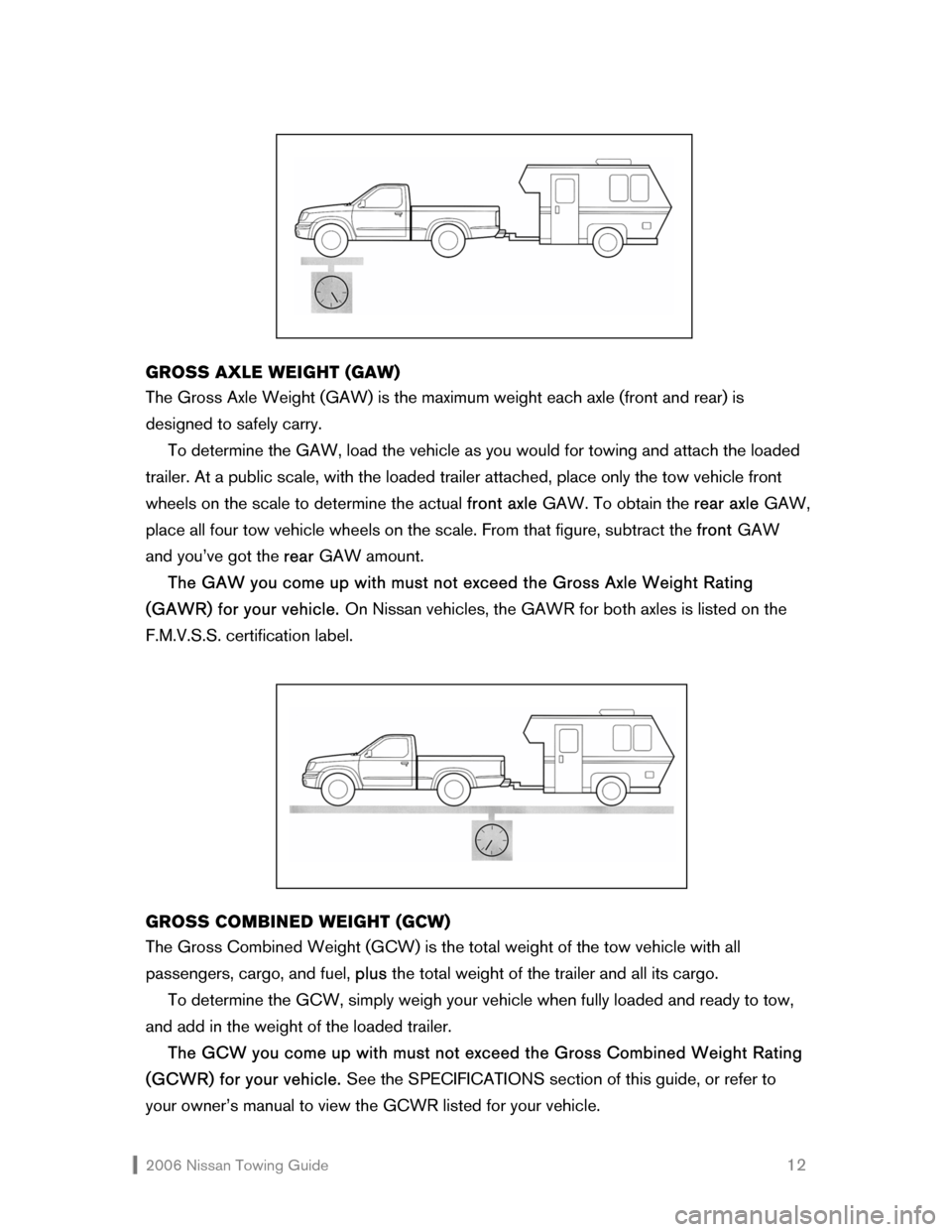
2006 Nissan Towing Guide 12
GROSS AXLE WEIGHT (GAW)
The Gross Axle Weight (GAW) is the maximum weight each axle (front and rear) is
designed to safely carry.
To determine the GAW, load the vehicle as you would for towing and attach the loaded
trailer. At a public scale, with the loaded trailer attached, place only the tow vehicle front
wheels on the scale to determine the actual front axle GAW. To obtain the rear axle GAW,
place all four tow vehicle wheels on the scale. From that figure, subtract the front GAW
and you’ve got the rear GAW amount.
The GAW you come up with must not exceed the Gross Axle Weight Rating
(GAWR) for your vehicle. On Nissan vehicles, the GAWR for both axles is listed on the
F.M.V.S.S. certification label.
GROSS COMBINED WEIGHT (GCW)
The Gross Combined Weight (GCW) is the total weight of the tow vehicle with all
passengers, cargo, and fuel, plus the total weight of the trailer and all its cargo.
To determine the GCW, simply weigh your vehicle when fully loaded and ready to tow,
and add in the weight of the loaded trailer.
The GCW you come up with must not exceed the Gross Combined Weight Rating
(GCWR) for your vehicle. See the SPECIFICATIONS section of this guide, or refer to
your owner’s manual to view the GCWR listed for your vehicle.
Page 14 of 28
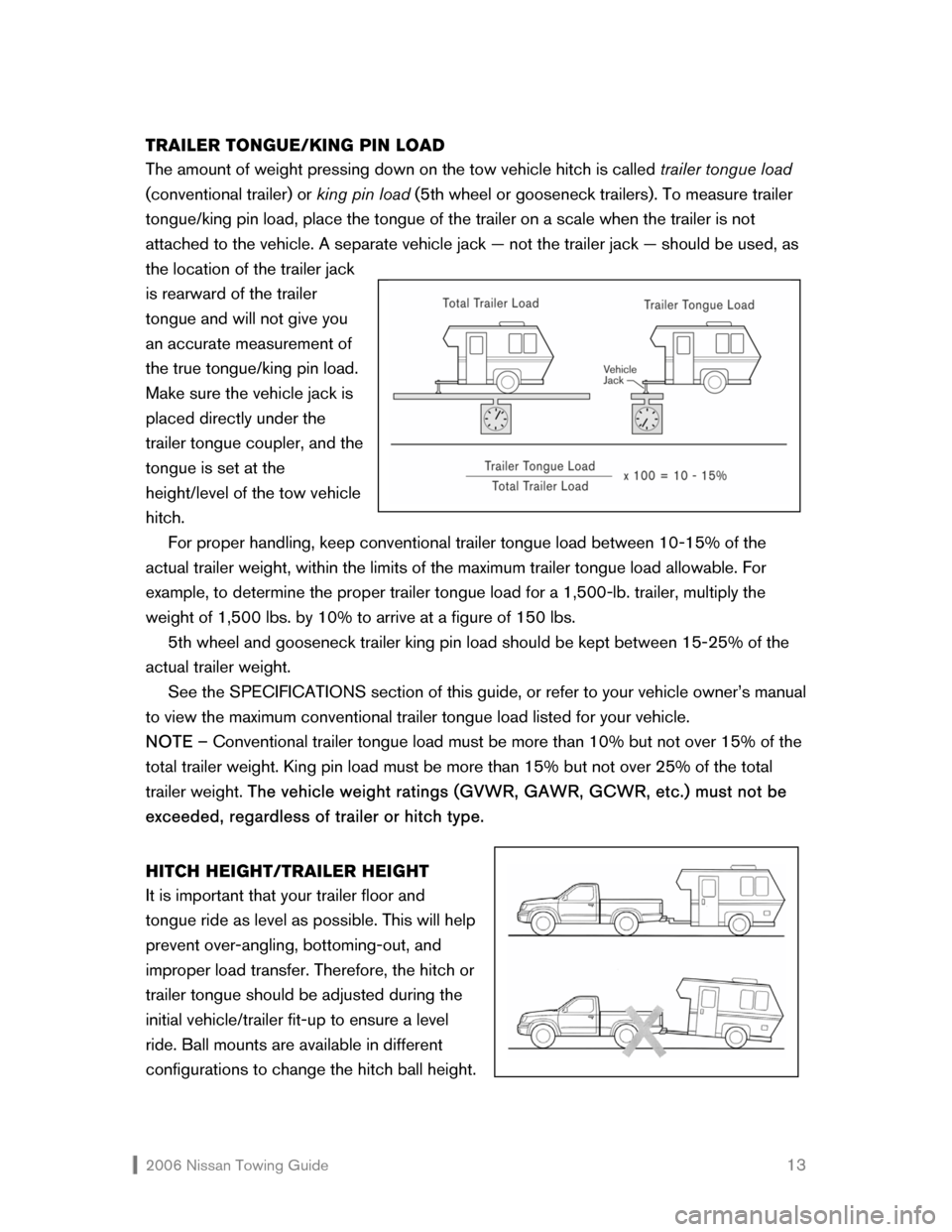
2006 Nissan Towing Guide 13 TRAILER TONGUE/KING PIN LOAD
The amount of weight pressing down on the tow vehicle hitch is called trailer tongue load
(conventional trailer) or king pin load (5th wheel or gooseneck trailers). To measure trailer
tongue/king pin load, place the tongue of the trailer on a scale when the trailer is not
attached to the vehicle. A separate vehicle jack — not the trailer jack — should be used, as
the location of the trailer jack
is rearward of the trailer
tongue and will not give you
an accurate measurement of
the true tongue/king pin load.
Make sure the vehicle jack is
placed directly under the
trailer tongue coupler, and the
tongue is set at the
height/level of the tow vehicle
hitch.
For proper handling, keep conventional trailer tongue load between 10-15% of the
actual trailer weight, within the limits of the maximum trailer tongue load allowable. For
example, to determine the proper trailer tongue load for a 1,500-lb. trailer, multiply the
weight of 1,500 lbs. by 10% to arrive at a figure of 150 lbs.
5th wheel and gooseneck trailer king pin load should be kept between 15-25% of the
actual trailer weight.
See the SPECIFICATIONS section of this guide, or refer to your vehicle owner’s manual
to view the maximum conventional trailer tongue load listed for your vehicle.
NOTE – Conventional trailer tongue load must be more than 10% but not over 15% of the
total trailer weight. King pin load must be more than 15% but not over 25% of the total
trailer weight. The vehicle weight ratings (GVWR, GAWR, GCWR, etc.) must not be
exceeded, regardless of trailer or hitch type.
HITCH HEIGHT/TRAILER HEIGHT
It is important that your trailer floor and
tongue ride as level as possible. This will help
prevent over-angling, bottoming-out, and
improper load transfer. Therefore, the hitch or
trailer tongue should be adjusted during the
initial vehicle/trailer fit-up to ensure a level
ride. Ball mounts are available in different
configurations to change the hitch ball height.
Page 15 of 28

2006 Nissan Towing Guide 14 TIRE PRESSURE
When towing a trailer, increase tow vehicle tire pressures to the recommended cold
specifications. You’ll find these figures in the owner’s manual and on the tire pressure chart
located in the vehicle. Trailer tire condition, size, load rating, and inflation pressure should
be in accordance with the trailer and tire manufacturer’s specifications.
TOWING
SAFETY
Towing can dramatically alter the handling and performance characteristics of your vehicle.
Plus, it puts increased strain on the engine and drivetrain. Therefore, it is always a good
idea to approach towing from the standpoint of safety — whether you’re purchasing
equipment or actually pulling the trailer.
Always make sure your vehicle’s towing capacity is adequate for the trailer you intend to
tow. Buy or lease only quality equipment, and have it installed only by professionals.
In addition, be certain that you have all of the equipment needed for safe towing,
including safety chains/cables, electric trailer brakes, electric trailer brake controller,
breakaway switch, extended rear view mirrors, and so on. All of these items have been
discussed in a previous section of this guide.
With regard to vehicle maintenance, you should follow a more frequent schedule, and
check fluid levels, pressures, tire condition, etc., more often when on the road. See your
owner’s manual for details.
LOADING YOUR TRAILER
Taking the time to load and balance your trailer properly will improve overall handling and
minimize the strain on your tow vehicle. Incorrectly loaded trailers tend to sway or swing
from side to side, upsetting vehicle handling. Careful loading and balancing can help
eliminate these problems.
As mentioned earlier, conventional trailer tongue load should fall between 10-15% of
the total trailer weight, and king pin load — if using a 5th wheel or gooseneck trailer —
should be between 15-25% of the total trailer weight. Excessive tongue/king pin load can
actually push the vehicle down in back, lifting the front wheels to a point where traction,
steering response, and braking are severely reduced. Insufficient tongue/king pin load can
cause instability, which may lead to “tail wagging” or jackknifing.
Page 16 of 28
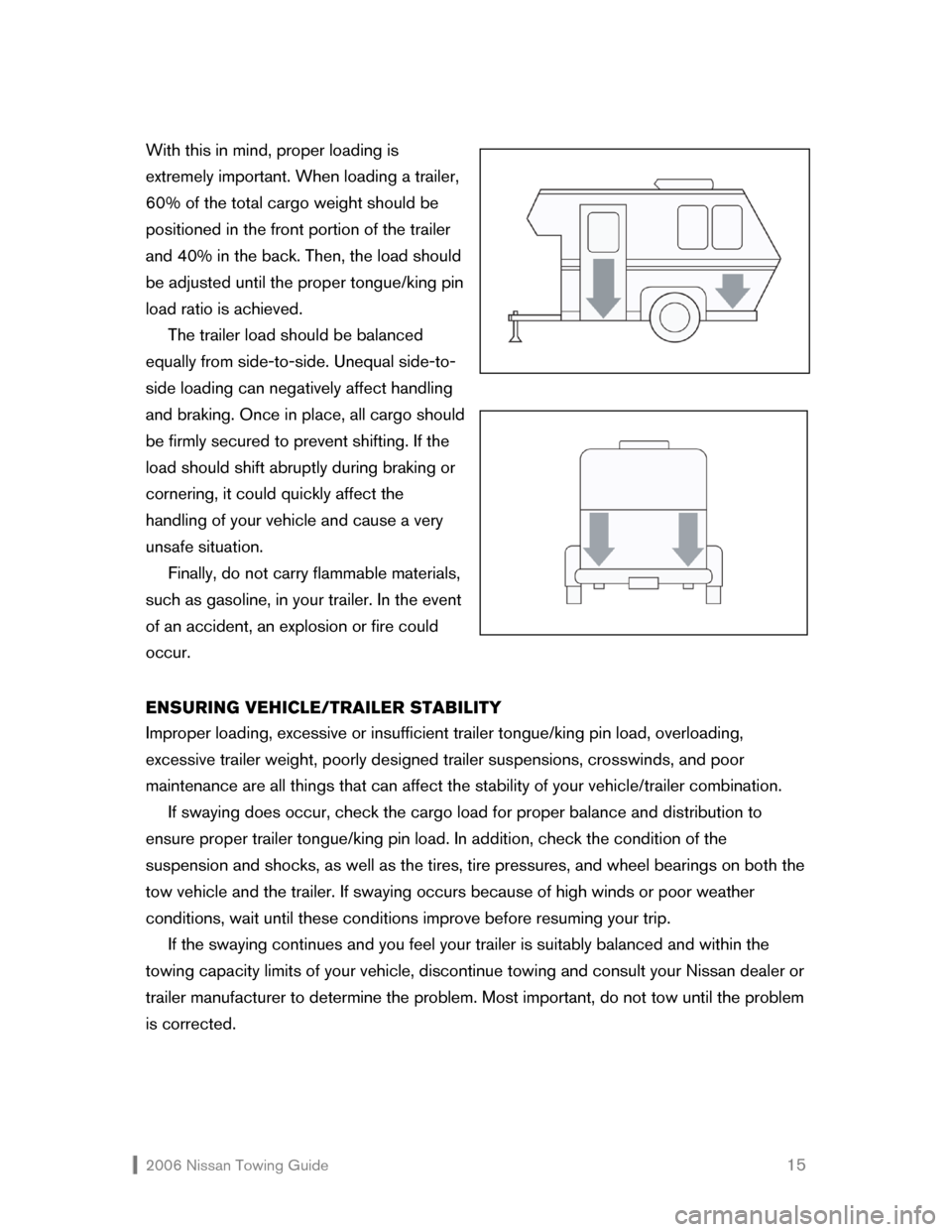
2006 Nissan Towing Guide 15 With this in mind, proper loading is
extremely important. When loading a trailer,
60% of the total cargo weight should be
positioned in the front portion of the trailer
and 40% in the back. Then, the load should
be adjusted until the proper tongue/king pin
load ratio is achieved.
The trailer load should be balanced
equally from side-to-side. Unequal side-to-
side loading can negatively affect handling
and braking. Once in place, all cargo should
be firmly secured to prevent shifting. If the
load should shift abruptly during braking or
cornering, it could quickly affect the
handling of your vehicle and cause a very
unsafe situation.
Finally, do not carry flammable materials,
such as gasoline, in your trailer. In the event
of an accident, an explosion or fire could
occur.
ENSURING VEHICLE/TRAILER STABILITY
Improper loading, excessive or insufficient trailer tongue/king pin load, overloading,
excessive trailer weight, poorly designed trailer suspensions, crosswinds, and poor
maintenance are all things that can affect the stability of your vehicle/trailer combination.
If swaying does occur, check the cargo load for proper balance and distribution to
ensure proper trailer tongue/king pin load. In addition, check the condition of the
suspension and shocks, as well as the tires, tire pressures, and wheel bearings on both the
tow vehicle and the trailer. If swaying occurs because of high winds or poor weather
conditions, wait until these conditions improve before resuming your trip.
If the swaying continues and you feel your trailer is suitably balanced and within the
towing capacity limits of your vehicle, discontinue towing and consult your Nissan dealer or
trailer manufacturer to determine the problem. Most important, do not tow until the problem
is corrected.
Page 19 of 28

2006 Nissan Towing Guide 18 CORNER MORE SLOWLY
Know your vehicle and trailer capabilities. Entering a sharp corner too quickly or abruptly
can “crack the whip,” whereby the trailer can actually pull the tow vehicle off the road.
Therefore, when approaching a relatively sharp corner, begin braking sooner than you
would when not towing. Do your braking in a straight line prior to the corner, and turn
smoothly into it. In addition, remember to make a wider turn than normal to ensure that the
trailer safely clears the inside of the turn.
When towing a 5th wheel or gooseneck trailer, do not make sharp turns while driving or
backing as the trailer may contact the vehicle and cause damage to both the trailer and
vehicle. A special extended 5th wheel pin box or sliding hitch may be required to provide
additional trailer-to-truck clearance for tight maneuvering.
BACK UP WITH CAUTION
Backing up with a trailer is a difficult maneuver; however, there is a “trick” that can simplify
the procedure considerably. Simply steer with one hand at the bottom of the steering
wheel. To turn the trailer to the left, first move the steering wheel to the left. To turn the
trailer to the right, move the wheel to the right. All movements of the wheel should be done
in small increments. Of course, backing up should be done only at very slow speeds. For
large trailers that obstruct your rearward vision, have someone outside the vehicle act as a
“spotter” to guide you along.
PARK SMART
A tow vehicle and trailer can be an unwieldy combination in a small area, so always try to
park where you will have a relatively easy time maneuvering. Once parked, always block the
wheels on both the tow vehicle and the trailer.
Parking on a slope is not recommended. If, however, you must park on a slope, and your
vehicle is equipped with an automatic transmission, there are some precautions you should
take:
�Š Have someone block the wheels once the tow vehicle and trailer are in position and
being held by the vehicle’s brake.
�Š Next, apply the parking brake, and only then move the gear lever into PARK. If you move
the lever into PARK before blocking the wheels and applying the parking brake,
transmission damage may occur.
HIGH-ALTITUDE PERFORMANCE
An engine will lose about 4% of its performance for every 1,000 feet above sea level that
you travel. If you will be towing in high altitudes, it’s a good idea to allow more time than
usual due to the engine’s reduced performance.
Page 22 of 28

2006 Nissan Towing Guide 21
TOWING
GLOSSARY
5TH WHEEL
HITCH Located just forward of the rear axle centerline, this hitch uses a king pin to serve
as the pivot point for the trailer.
BALL MOUNT A bar that holds the hitch ball and is inserted into the hitch receiver. Also
commonly called a drawbar or “stinger.”
BREAKAWAY SWITCH A safety device using a trailer battery that automatically applies the trailer’s
brakes if it should accidentally become separated from the tow vehicle. A
breakaway switch may be used with both electric or surge trailer brake systems.
BUMPER HITCH A reinforced bumper designed to accommodate a hitch ball.
ELECTRIC TRAILER
BRAKES When the brakes on a tow vehicle are applied, an electric current is sent to an
actuator which applies the trailer’s brakes.
ELECTRIC TRAILER
BRAKE CONTROLLER A device that controls the electric trailer brakes.
GOOSENECK HITCH Located just forward of the rear axle centerline, this hitch uses a ball to serve as
the pivot point for the trailer.
GROSS AXLE
WEIGHT RATING (GAWR) The maximum amount of weight each vehicle axle (front and rear) is designed to
safely carry.
GROSS COMBINED
WEIGHT RATING (GCWR) The maximum allowable combined weight of the vehicle and trailer, including
passengers and all cargo.
GROSS VEHICLE
WEIGHT RATING (GVWR) The maximum allowable weight of the vehicle, including passengers, cargo, fuel,
hitch, trailer tongue load, and any optional equipment.
KING PIN
LOAD The amount of trailer (5th wheel or gooseneck) weight pressing down on the tow
vehicle hitch.
HITCH BALL
A ball that connects the trailer to the tow vehicle hitch and provides the means
by which the trailer pivots during cornering. Available in a number of sizes and
weight capacities, it must correspond to the trailer coupler size, and have a
sufficient capacity rating for the trailer being pulled.
RECEIVER HITCH A frame- or structure-mounted hitch with a receiver that allows removal of the
ball mount.
SAFETY CHAINS/CABLES Provides an emergency connection between the tow vehicle and the trailer,
should the trailer become disengaged for any reason.
SURGE BRAKES
Hydraulic-type braking system activated by inertia. As the tow vehicle begins to
brake, the trailer pushes against the hitch ball, consequently activating the trailer
brakes.
TRAILER TONGUE/COUPLER The part of the trailer that extends forward to meet the tow vehicle, and also
carries the coupler assembly.
TRAILER TONGUE
LOAD The amount of trailer (conventional) weight pressing down on the tow vehicle
hitch.
WEIGHT-DISTRIBUTING HITCH
SYSTEM Type of hitch system that helps shift the trailer tongue weight to all trailer tires
and the tow vehicle front tires. Strongly recommended when towing trailers with
a Maximum Trailer Weight greater than 5,000 lbs.
WIRING HARNESS
Provides an electrical connection linking the tow vehicle’s electrical system to
the trailer’s system.